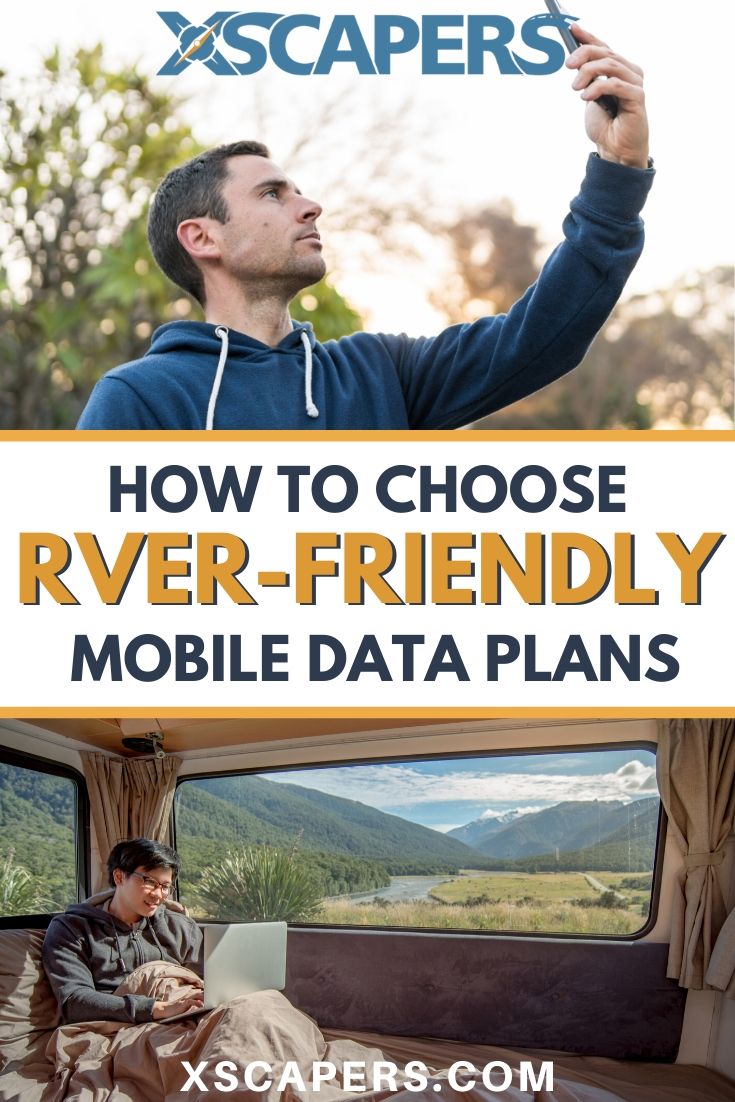
Choosing a cellular data plan can be overwhelming for anyone.
But when you’re a full-time or seasonal RVer, the decision comes with some additional considerations you may not have thought about before.
In a sticks-n-bricks home or office, you probably relied on a cable or DSL for your internet source. And it was likely really truly unlimited, and fast. But those options aren’t readily available when RVing.
There may be times when you’re able to use the Wi-Fi network at a campground or coffee shop. But for the most part, cellular service from Verizon, AT&T, T-Mobile and/or Sprint will likely now be your main source of getting online.
Which means you need to find plans that include copious amounts of data to get your devices online for everything you might want to do – more than just checking your e-mail, or playing a bit of Pokemon.
The cellular carriers, for the most part, just don’t currently design their plans to be suitable as a primary home or office connection. They all assume that you have a cable or DSL ‘at home’ and your cellular data plan is just a supplement.
You might watch a YouTube video on your smartphone on the commute home by public transit, but you’re presumed to watch your primary shows over cable, satellite or a wired internet connection.
On the road however, our cellular data plans are often all we have. They become what we use to stay in touch with friends & family, post to social media, read blog articles, stream TV shows & movies, play online games, update our computers, back-up to the cloud – and oh yeah, work remotely.
15-30GB of hotspot data a month just isn’t going to cut it. Many of us desire 100s of GBs of data a month.
It’s important to understand some of the lingo that the cellular carriers use to describe their plans and what their limitations are to determine if a plan is suitable or not for your mobile lifestyle needs.
Here’s an overview of some of the terms you’ll want to learn and pay attention to when shopping for a plan:
Unlimited Mobile Cellular Data Plans
Let’s face it – you’re just going to have to redefine the word ‘unlimited’ if you’ll have any hope of navigating the carrier’s plans.
While unlimited might reasonably mean no limits to most of us – in the mobile internet world, ‘unlimited’ often comes with serious limits hidden in the fine print. The carrier’s have successfully been able to market that this word really just means that there are no overage charges.
Many unlimited plans, unfortunately, come with heaps of limits.
There may be limits on how much of your ‘unlimited’ data is actually promised to be full speed data before a slowdown. Or limits on what resolution you can stream videos at. Or limits on how much data you can use as personal mobile hotspot to get your laptops and streaming devices online.
There are rare truly (or mostly) unlimited plans out there, but they may require a bit of ‘thinking outside the box’ to acquire and take advantage of them.
Mobile Hotspot

Mobile hotspot is a term for using your cellular data as your internet source over a private Wi-Fi or wired network – like laptops, streaming devices, tablets and more. It’s sometimes also called tethering.
This could be as simple as using your personal mobile hotspot feature on your smartphone, or using a dedicated data device like a mobile hotspot device (Jetpack/Mifi) or cellular embedded router.
Many carrier direct cellular data plans – while including unlimited use on your smartphone or tablet itself – will have restrictions on how much data can be used as a hotspot.
And this restriction right here is the arch nemesis of RVers seeking a primary cellular data connection. We don’t want to just use our data on our smartphones, we want to get all of our devices online.
The data plans offered directly from the carriers tend to have limitations on mobile hotspot use – both for smartphone plans and data only devices.
Throttling vs Network Management
These two terms are similar and are frequently confused.
Throttling means always reducing data speeds to a set level. This term typically comes into play when you have a data cap on your plan. Once you’ve hit your data cap, your speeds will be throttled (reduced) down to a lower speed. This speed reduction is for the remainder of your billing period, regardless of local cellular tower conditions. And this reduced speed is often to an essentially unusable level.
Network Management, on the other hand, refers to a carrier’s ability to prioritize traffic on their network. If a carrier has a tower that is getting a lot of traffic and it is congested, customers who have crossed their network management threshold will get lower priority on the network and may experience slower speeds until the congestion clears up. It is a temporary condition – much like rush hour traffic only results in slower speeds during a few hours a day. And often the slowdown is slight – and may be barely noticeable.
Video Resolution
Streaming video on Netflix, YouTube, Disney+, Hulu and more are a common way RVers get their entertainment fix.
All of the carriers know there is consumer demand for this, but video streaming is one of the most data intensive things you can do online.
As more streaming services offer 4K video for super crisp high resolution experiences, the carriers have implemented video throttling policies to manage their capacity.
So even if you have a solid enough signal to get speeds fast enough for smooth 4K video streaming – your plan may actually throttle video traffic to a lower resolution.
Entry level plans may throttle video down to as low as ‘DVD quality’ which is a paltry 480p. Other plans may still offer High-Defiition (HD) resolution at either 720p or 1080p – which is fine for most screen sizes.
Pay particular attention to the video streaming resolution policy of your plans if you need to do video broadcasting or conferencing as part of your remote work – these resolution caps might also apply there, and could impact the quality of your experience.
Finding Your Ideal Plan – They Come and Go
The carriers are constantly changing up their plans to remain competitive.
And some plans pop-up for a short time period that are particularly attractive for RVers to deliver massive quantities of high speed hotspot data.
And other plans are out there that aren’t intended for mobile hotspot use, but are usable if you know some tricks and are willing to bend some rules
Available plans can – and do – change very frequently.
We track these plans closely for our fellow RVers for each of the major carriers.
As you’re ready to shop for your next data plan, head on over to the Mobile Internet Resource Center to see what our current Top Pick data plans are:

Authors
Cherie Ve Ard and Chris Dunphy
Cherie Ve Ard and Chris Dunphy of Technomadia.com have been living and working full-time on the road since 2006, and Internet connectivity has been essential to them every step of the way. To help other RVers with the challenges of staying connected, they co-authored The Mobile Internet Handbook, and in 2014 they launched RVMobileInternet.com to provide unbiased information, reviews, resources and tutorials to help us all stay better connected on the road.
Did you like this post? Pin it on Pinterest!











